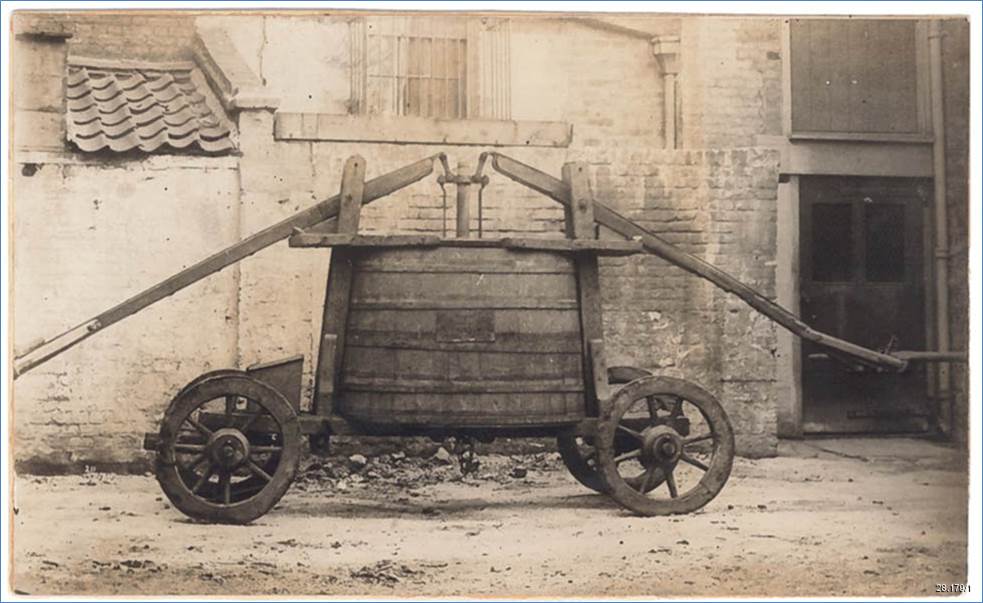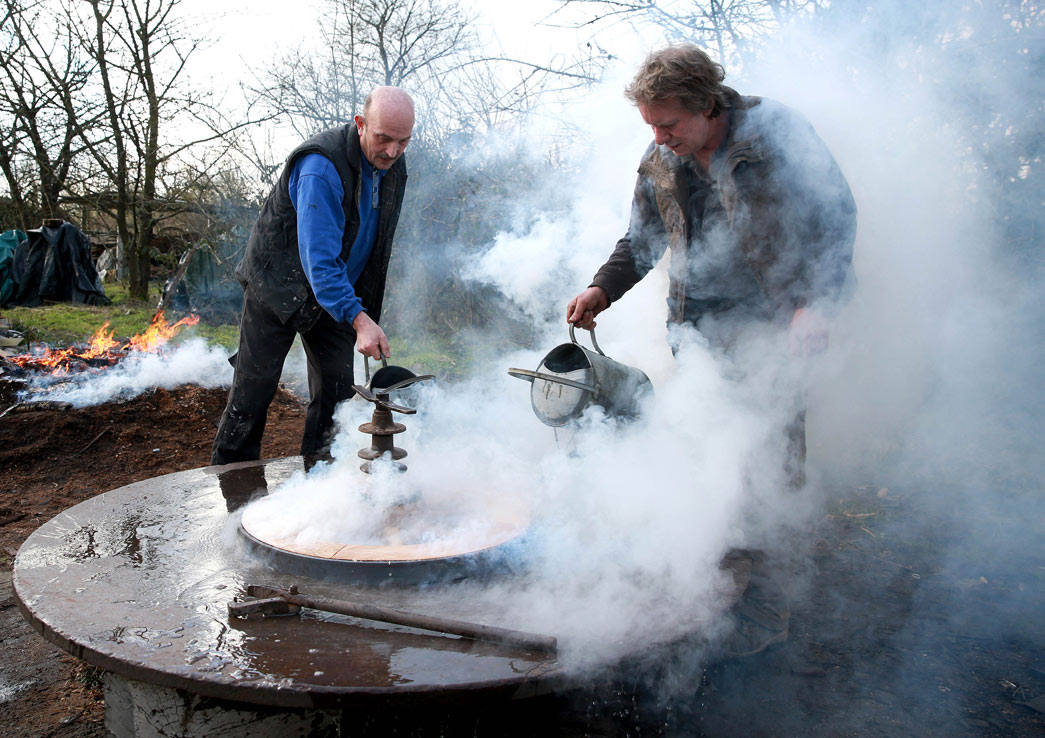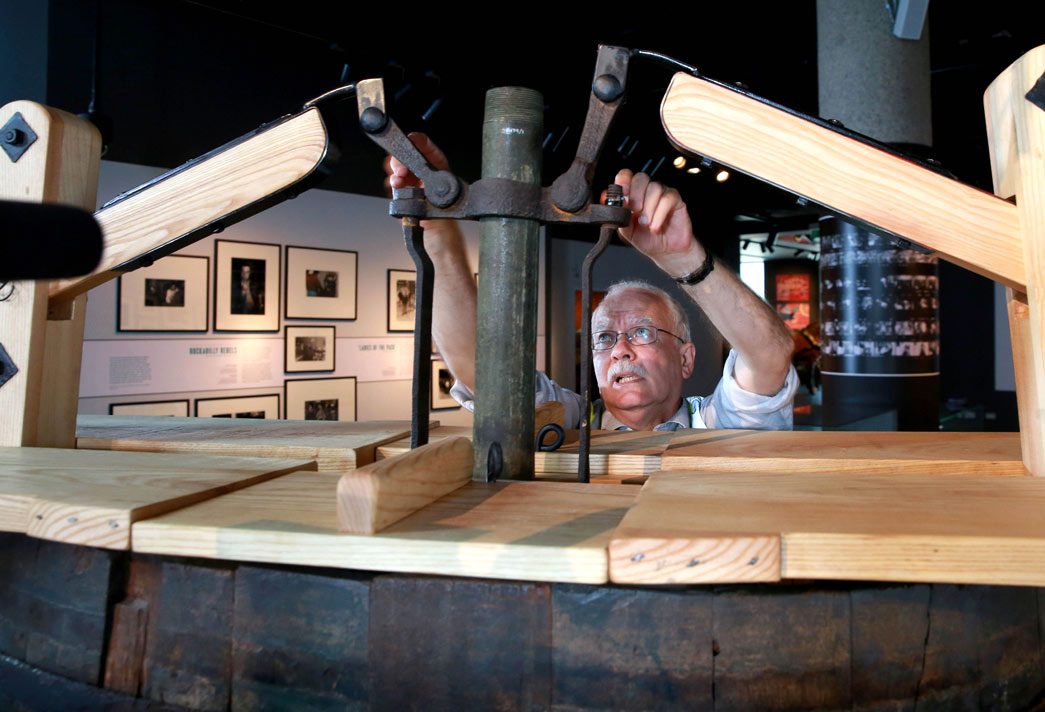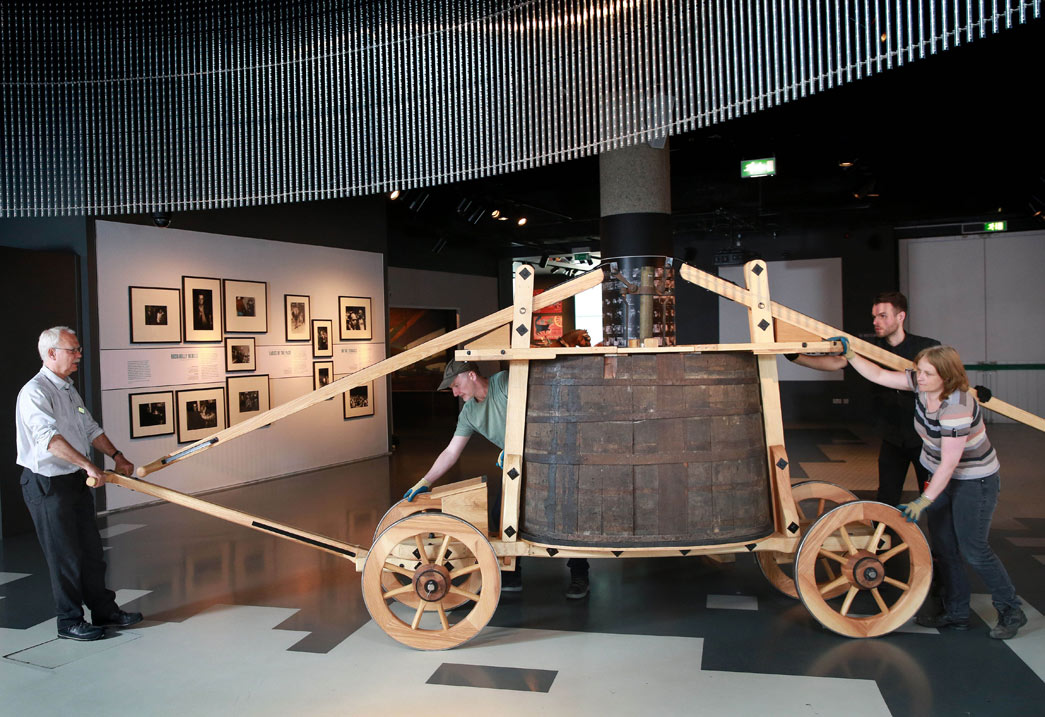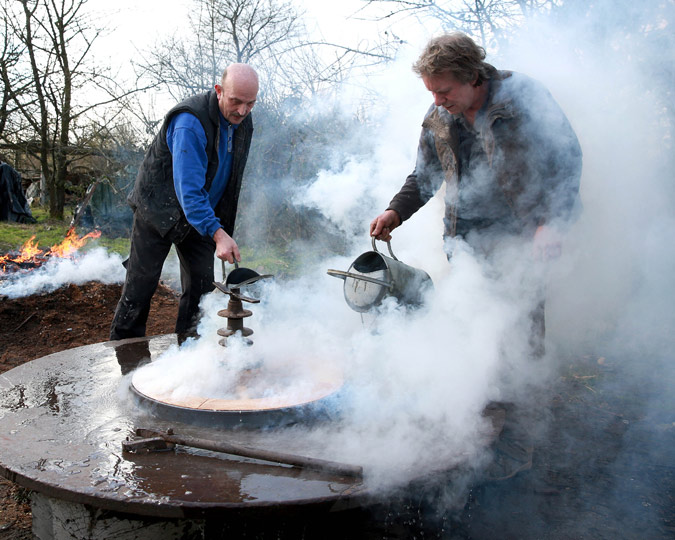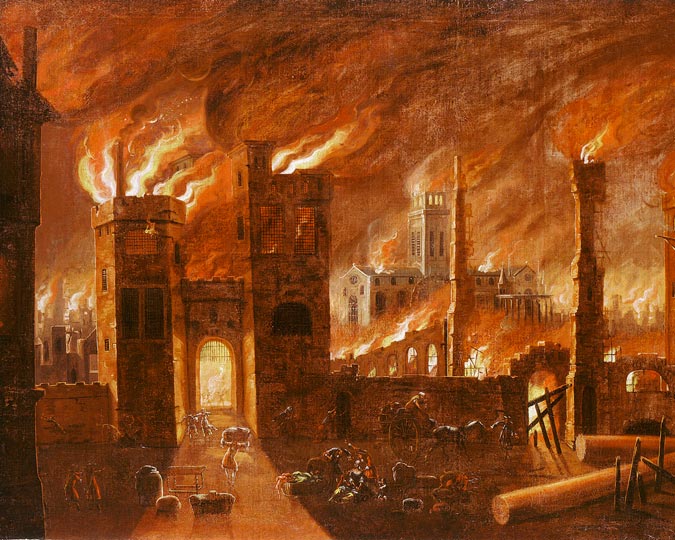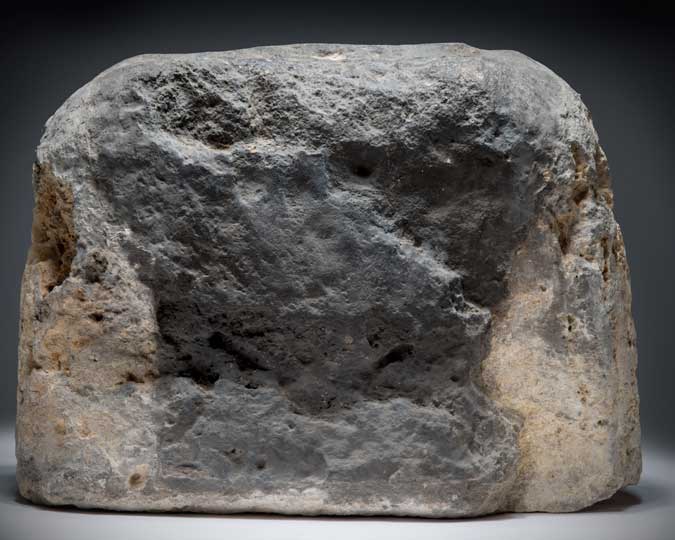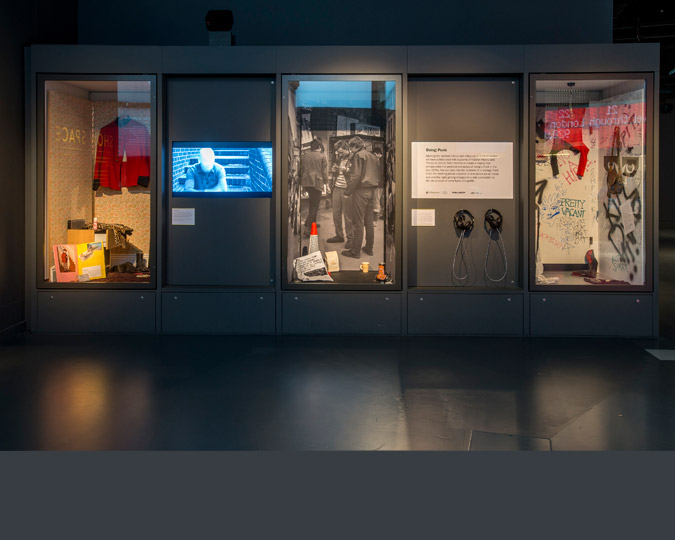One of the key exhibits in our Fire! Fire! exhibition is an extremely early surviving fire engine, made by John Keeling in London around 1678. The conservation of this rare fire engine proved to be quite a challenge, revealing some surprising secrets. We spoke to head of Conservation and Collection Care, Rob Payton, about transforming this machine.
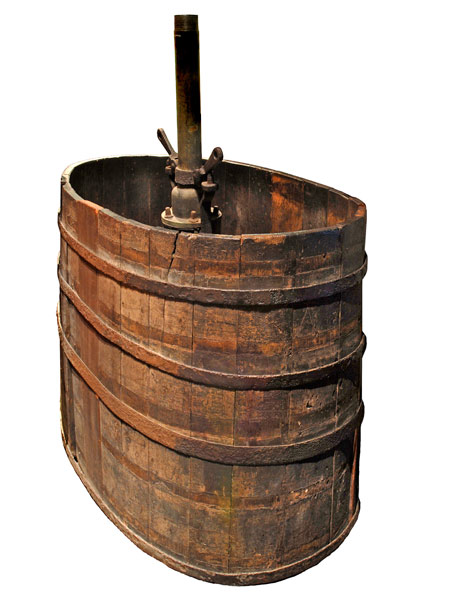
The fire engine before restoration
Central barrel and iron pumping mechanism; ID no. 28.179/1
Why did this fire engine need restoration? What sort of state was it in before?
We've had this object on display in the museum for years. It was labelled as a fire engine, but it looked like just a large barrel, with a weathered column of iron and copper alloy in the middle. It’s been like that since it first arrived in the London Museum, back in 1928. We were very surprised to discover an early photograph of the fire engine, probably Victorian or Edwardian, that showed it intact- with wheels and pumping arms attached. We also found a print, held by the Pepys Library in Cambridge, which showed Keeling’s original design in use. So we knew we had a lot of rebuilding to do.
How did you reconstruct the lost bits of the engine?
We worked with a company named Croford Coachbuilders, who are some of the only people in the country who can do this kind of work. This is a hugely complex project- it requires not just great accuracy, but also familiarity with skills that have been out of use for decades. They were thrilled to be asked, it was an excellent challenge for their team. We were very confident in them as well, because they’ve been working with us for over twenty years, helping us to keep the Lord Mayor’s coach in good condition.
The artisans from Croford visited the museum to measure the surviving fire engine. Ideally, they would have built the new parts around the barrel, but we needed to keep it on display. Instead, they had to rely on the accuracy of their measurements, and then to use the photograph to guide the size of every piece they made.
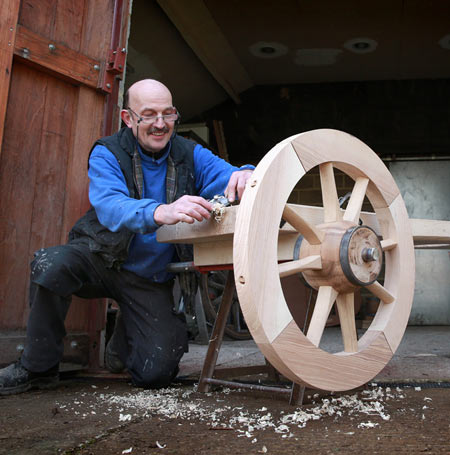
Tim Brisley of Croford Coachbuilders shows the wheel of the engine
Matt Alexander/PA Wire
We weren’t trying to make a pastiche, a fake version of the
original fire engine. It’s very obvious which parts are replicas and which
parts are original. Instead, it’s about working out what the engine looked like
in its heyday, and how it worked. That meant using original materials, and,
wherever possible, using the same techniques that would have built the engine
in the 17th century.
The wheels alone are made of three different types of wood. The hub is made of elm, which is very robust and resistant to splitting, it can take a lot of knocks. Then you have oak spokes, for their strength. The felloes, the pieces that go round the spokes, are made of ash, strong and springy. Then, finally, there’s an iron rim, that was actually made to be slightly smaller than the wheel.
Smaller? Then how does the rim fit around the wheel?
The initial fit of the wooden pieces was quite loose. We carried those out into the coachmaker’s yard, and the metal rim was heated on a bonfire of wood chippings. The iron expanded- just enough to fit the rim onto the edge of the wheel. Quickly, before the glowing metal can set fire to the ash, it was doused with cold water. As it cools, the metal contracts, and it clamped the wheel together. The hot metal sent up great clouds of steam, and you could hear the wood creaking as it tightens. You can see that in the film that we produced.
The resulting wheel is a beautiful, tight-sprung thing. When you knock the wood, it rings almost like a bell. There’s a kind of magic in it.
What did you do once the new pieces had been made?
We took all the finished components to our archive at Mortimer Wheeler House, where the museum’s collection of antique vehicles is stored. There, we slotted them together to make the completed engine- and the fit with the original barrel was perfect, almost to the millimetre.
Were you worried about damaging the surviving engine?
There’s actually a small gap left between the wooden uprights and the barrel. In reality, they would have clamped it in place, but we left a little air to avoid any scratching.
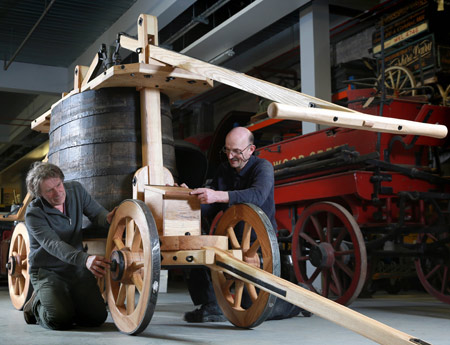
Croford Coachbuilders assemble the fire engine at Mortimer Wheeler House
Matt Alexander/PA Wire
Were there any
unexpected problems?
The biggest surprise was that, once we hoisted the barrel up
to place it on the undercarriage, we discovered it had no bottom attached to it.
Obviously not ideal in terms of transporting water. Also, the bottom edge was
very rough and uneven. I’m pretty sure that the wood of the bottom rotted,
being waterlogged, and someone who owned it before the museum responded by
sawing off the bottom. That probably accounted for the loss of the wheels and
undercarriage, as well. And we discovered this only through rebuilding the
engine.
You may have heard of experimental archaeology- building
wattle-and-daub huts, that kind of thing. What we’ve done is experimental
technology, and we now have as close as we can get to a surviving 17th
century fire engine.
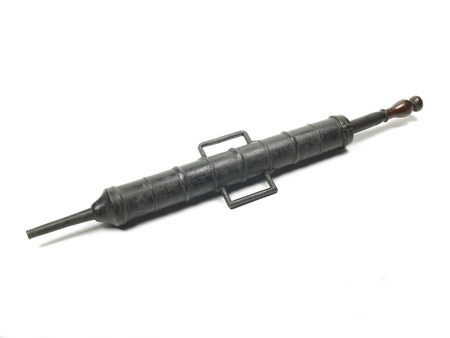
Hand held squirt
Used around the time of the Great Fire; ID no. B741
Would a fire engine
like this actually have been used during the Great Fire in 1666?
Although some fire engines were used to try and fight the
Great Fire, they weren’t that effective. The fire was a great impetus to
develop better fire-fighting techniques. This engine was developed by John
Keeling, in about 1678, in his workshop in Blackfriars. At the time they had
squirts- rather like big metal syringes- but they didn’t do much. There was a
market for better fire-fighting technology, from the government and also from
the newly-created insurance companies.
So what have you
learned from reconstructing the fire engine?
Firstly, that it was incredibly heavy. Even without any water in it, it weighs over a half a ton. It rolls alright over level, smooth ground, but the operators would have had real difficulty pulling this uphill, or over rough ground. It also has a very poor turning circle. So in other words, this engine could only have been used in wide, well-maintained streets- in other words, the richer parts of town. If you tried to take it down narrow lanes, with ruts or cobblestones- forget it.
Experimental reconstruction also enabled us to work out how the engine actually worked, and how efficient it was. The two pump arms worked a metal piston in the middle of the barrel, pushing water up like a giant syringe. Men at both ends would have had to push the pumping arms at the same moment to drive the piston. And the resulting water pressure was pretty pitiful. I estimate the fire engine would have emitted about six pints of water per squirt, and the water would have travelled no more than 5 metres.
That’s not going to make much impact on a big fire.
Exactly- and the machine would have to get dangerously close to the blaze. We even have some records of early fire engines catching fire! I suspect that Keeling’s fire engine was hazardous to the operators. The man directing the spray of water would have had to stand on a narrow platform on top of the engine, with buckets of water being poured into the barrel next to his feet. It would make for a very unsafe working environment.
So we’ve restored a somewhat useless machine?
Technology always proceeds by experiment. It was only because of these- as they turned out- highly inefficient machines that people were able to figure out what worked and what didn’t. About this time Dutch engineers had developed riveted leather hoses that had a great impact. They meant that fire-fighters were able to continually feed water to the engine, as well as to get closer to the fire. Some pumps are said to have sprayed the water up to eighty feet.
This project has given us a window into the development of firefighting technology that eventually culminated in modern fire engines.
Rob, sadly this will be one of the last projects you oversee at the museum.
Yes, I’m retiring just before the Fire! Fire! exhibition opens. This is a wonderful swansong for my career at the museum. Seeing an object go from a stale, static display to a star exhibit is fantastic. To me, this fire engine really epitomises the museum’s collections. They’re full of hidden treasures, and much of what we do, as conservators, is to unearth those. Conservation is about enabling the public to see the real value of our objects. I’ve spent 28 years at the Museum of London, and this is the perfect project to end on.
Fire! Fire! ended in 2017.
The restoration of the fire engine has been supported by:
The Worshipful Company of Coopers
The Worshipful Company of Grocers
The Worshipful Company of Joiners and Ceilers Charitable Trust








